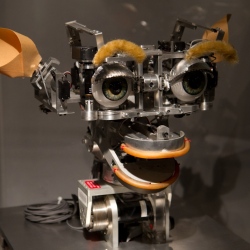
Finally, the robot revolution is arriving. There’s a Cambrian explosion in robotics, with species of all sizes, shapes and modes of mobility crawling out of the muck of the lab and onto the terra firma of the marketplace, about to enter your home and your shopping experience. Here’s why…
4 Converging (Enabling) Technologies
Four converging tech areas enable the revolution. I write about this in detail (both the technologies and business opportunities) in my next book BOLD (coming out February 2015). See if this makes sense…
Sensors: The sensors that cost you $10 today would have been military secrets costing you tens of thousands of dollars 20 years ago. Sensors that listen, look, feel and navigate are plummeting in cost, size, weight and power consumption, thanks to the smartphone revolution.
Infinite Computing: Your mobile phone processor is a supercomputer from 20 years ago. Better yet, it’s connected to the cloud and enables near-infinite computing. Combined with sensors, this allows robots to have situational awareness and “comprehend” contextual information in real time.
3D Printed Parts: Smart design software and 3D printing technologies are allowing entrepreneurs to rapidly design, prototype and build novel robots and test them in the market before committing to production.
Open-Source Movement: There is a massive online open-source movement sharing designs, posting software updates, answering questions and more. Whatever expertise you need you can find online, 24×7, for free. Post a question, get it answered.
5 Top (Consumer) Robotic Applications
In the near future, we’ll see robotics make a significant impact in the following areas:
Drones: You can now buy a drone that sends images to your iPhone for $50. This technology would have been highly classified as a military secret 10 years ago. Another one hovers and takes your selfie. Others will image your home on demand or carry your package from village to village.
Autonomous Cars: Make no mistake, autonomous cars are robots, and every major car company is working on their own version. This year, Google’s self-driving cars have logged over 1.2 million autonomous miles. Tesla’s recently announced Model D has an autopilot and will park itself in your garage (assuming you own it).
Retail: Fellow Robots has partnered with Lowe’s to supply their first generation of “OSHBots”; autonomous robots that know where all of the store’s merchandise is located, can navigate the aisles on their own, can interact with customers with natural language (in multiple languages), and help you fulfill your visit to the hardware store quicker and easier.
We’re also seeing the introduction of robotic guards (Nightscape’s K5 & K10) that will roam your store looking for intruders. Then there’s Savioke’s Botlr robot. Botlr is a fully autonomous robotic hotel servant, programmed with a detailed map of the hotel and able to deliver a toothbrush, boarding pass or newspaper to a guest’s room.
In Your Home: It started with the Roomba years ago. Now, I have Suitable Technology’s Beam telepresence robot that I use to visit with my kids during breakfast or dinner. I can pilot my Beam robot around the house, find my kids and chat with them. I also use the Beam (12 of them in total) in all of my corporate locations.
Healthcare: Robotics have hundreds of applications in healthcare and medicine. Robotic surgeons, like the da Vinci robot, will perform more accurate surgeries without the limitations of humans (shaky hands, lack of sensors, viewpoint limitations). Robot nurses will patrol the hallways of hospitals monitoring the vitals of patients and alerting doctors to urgent situations. Telepresence robots will allow the best diagnostician to beam in and consult on your case. Robots will help nurses lift heavy patients, and other robots will provide affection and mental stimulation to the old and frail.
